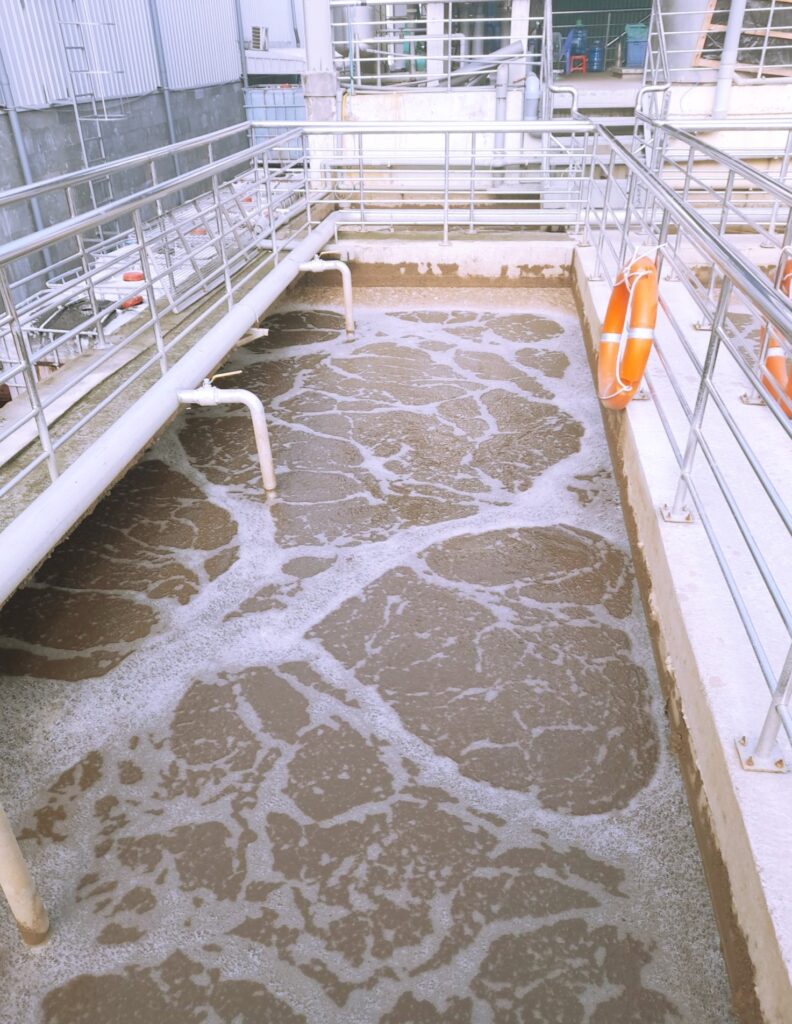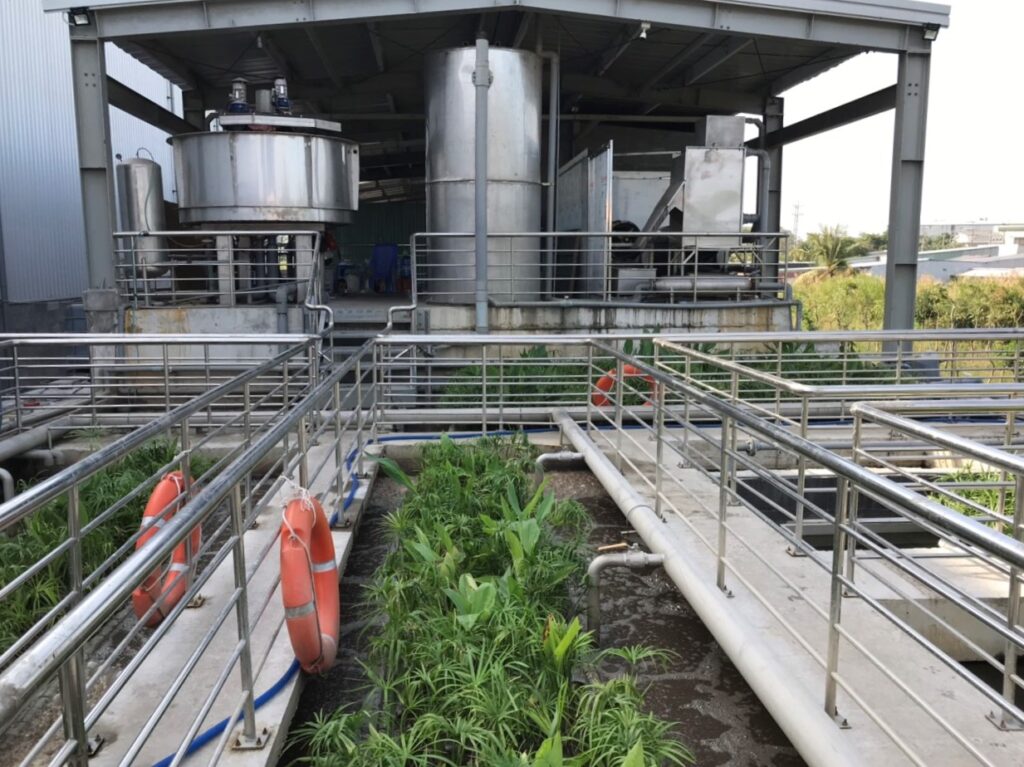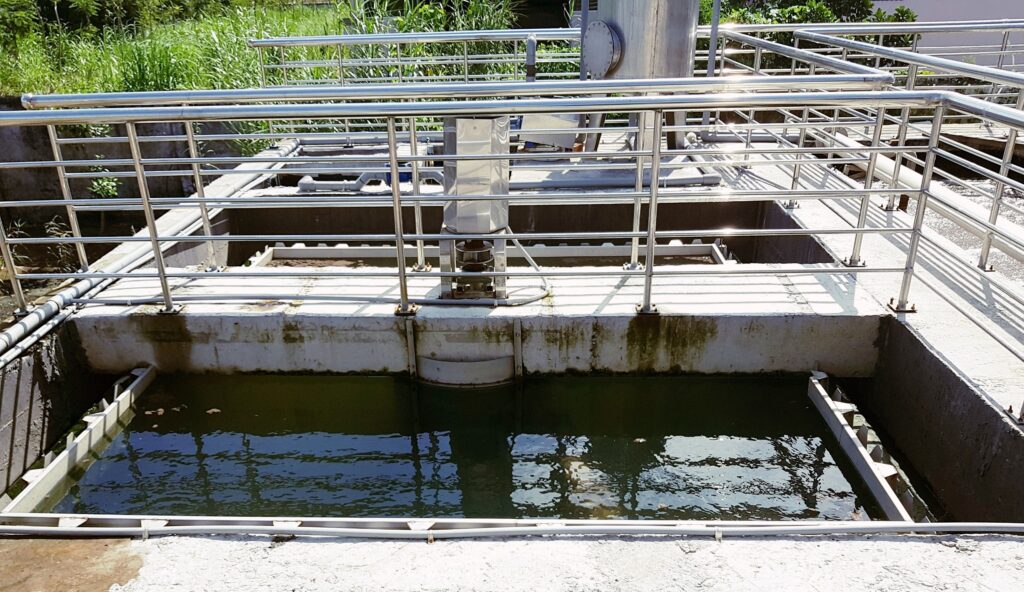Project
MFC Wastewater treatment system of producing hydrolyzed protein and oil
Project explanation
Collection tank: Waste water from the production stages of the factory follows the drain system and flows through the collection tank.
Garbage separator: Wastewater from the sump is pumped to the garbage collector. Here garbage, fat, debris, fins, fish bones … mixed in wastewater will be retained and collected; This component can be used as animal feed or sent to a sanitary landfill.
Conditioning tank: Wastewater after being led into the collection tank is concentrated into the conditioning tank. The tank has the following main functions:
Stabilize flow, flow, concentration of dirt, pH;
Create a stable working mode for the rear processing stages, avoid overload, and ensure that the system always operates stably;
Preliminary ventilation and odor reduction due to continuous aeration
DAF pressure flotation equipment cluster: The peculiarity of fish processing plants is that wastewater contains a lot of fat, fish blood exists in the form of suspended sediment and suspension, so this fat cannot be separated by the method of sedimentation. normally. Therefore, we have to perform pressurized flotation. This process is used to remove substances that can float on the surface of wastewater such as oil, fat, blood, and suspended solids.
Pre-anaerobic tank: Has the effect of storing water after DAF flotation to continue to be pumped and circulated into the anaerobic tank
Anaerobic tank (UAFB): Wastewater after passing through the DAF will be pumped by 2 floating pumps into the anaerobic tank according to the bottom level principle. Here the pollutants will be decomposed by anaerobic microorganisms in the anaerobic sludge layer. Through this anaerobic microbiological tank, the concentration of pollutants (COD, BOD, Nitrogen, Phosphorus, …) will be significantly reduced. Then the wastewater will be circulated through the anaerobic tank.
Post-anaerobic tank: Wastewater after going through the anaerobic digestion process will be transferred to the post-anaerobic tank to continue through the next process. This tank only has the effect of storing water before passing through the Anoxic tank, but has no treatment function.
Anoxic biological tank: Anoxic tank is an anoxic biological process. When wastewater is led into this tank, there will be the reactions of Nitrification and Phosphorite. The Anoxic tank is equipped with a submersible stirrer with the task of stirring the water stream continuously at a steady speed to create an oxygen-deficient environment, helping anoxic microorganisms grow.
Aerobic + MBBR biological tank: In the MBBR attached aerobic tank, an air supply system is provided to create conditions for aerobic microorganisms to grow and develop. At the same time, the gas supply process must ensure that the materials are always in suspension and continuously disturbed throughout the reaction process. Microorganisms capable of decomposing organic compounds will adhere and grow on the surface of materials. In addition to the task of treating organic compounds in wastewater, in the suspended aerobic biological tank, the process of nitrification and denitrate takes place, helping to remove nitrogen and phosphorus compounds in wastewater.
Aerobic biological tank: is an aerobic biological treatment process with activated sludge to remove organic impurities, convert and use nutrients in wastewater (COD, BOD5, TSS, N, P, etc.) …) in the condition of continuous air supply by the gas distribution disc system.
Phase separation tank: The phase separation tank is responsible for retaining a part of the sludge to circulate to the biological tanks and to the sludge tank if there is excess, avoiding the concentration of sludge in the settling tank, which will cause the sludge to float through the storage tank.
Sedimentation tank: Settling tank is responsible for separating the sludge and clear water. The sludge will be circulated back to the biological tanks and pumped out to the sludge tank if there is excess, the clear water will follow the water collection trough through the storage tank before being pumped into the coarse filter.
Post-settlement tank: The storage tank is an intermediate water tank before going through the pre-filtration tank
Pre-filter device: After settling through the tank, there are many components such as: eggs, suspended sediment. Therefore, the water needs to go through the coarse filter to remove these suspended substances, making the water clear and meeting the discharge standards.
Disinfection tank: Finally, the stage of wastewater disinfection after treatment, Ozone aeration aims to completely kill coliform and other disease-causing germs. The sterilization tank is designed with 2 baffles connecting the bottom of each other, creating a long path and enough time to contact ozone gas with wastewater. The sterilization efficiency is 95% with coliform and 100% with other pathogens.
Sludge storage tank: The amount of sludge generated in the phase separation tank and settling tank is taken to the sludge tank
Sedimentation tank: The residue from the flotation stage will be led to the sludge storage tank. Here the residue will be pumped to the mud press for continuous pressing divided into 2 shifts day and night (squeeze the sludge according to the operating time of the plant).
Project image
You need a wastewater treatment solution like this one?
Please contact us for a complete and in-depth consultation










